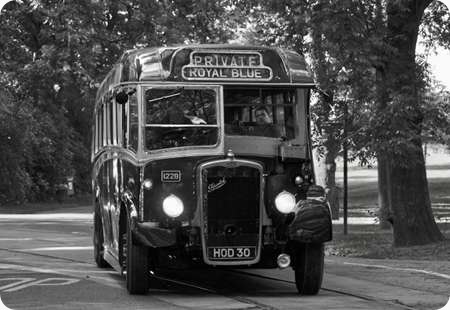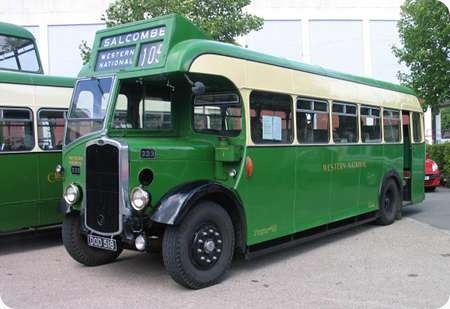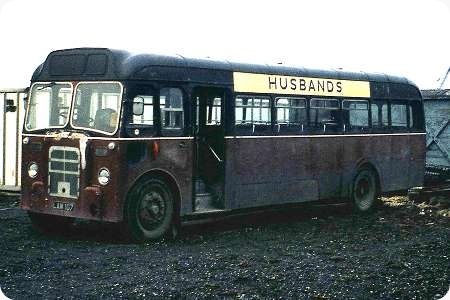
Western National Omnibus Co Ltd
1948
Bristol L6A
Beadle C31F
H0D 30 is a Western National Royal Blue with fleet number 1228 dating from 1948. It’s a Bristol L6A
with Beadle C31F body. It is fitted with a 7.7 litre AEC engine as specified by Royal Blue, the
coachwork largely to Duple design, was contracted out to Beadles of Dartford as the coach building
capacity during the post war recovery period was overstretched. It features staggered seating to allow a
little more elbow room in the 7’6” width of the vehicle.
Withdrawn from service in 1960, HOD30 was
one of a number of vehicles sold to a china clay company for staff transport which aided its survival
until 1968 when it was finally withdrawn.
It had a number of owners between 1960 when it was taken
out of service to when Greg Lawson acquired it in 1996. It is part of the growing number of Aire Valley
heritage fleet vehicles
The picture was taken in 2011 at the Heaton Park rally
Photograph and Copy contributed by Ken Jones
14/06/13 - 07:47
I’m not sure just how correct Ken is in saying that Royal Blue
"specified" the AEC engine. It is true that it is the basically the same engine as that
specified in Royal Blue’s 1937 batch of AEC Regals, fleet nos 1050-1065, but the first post war
batch of JUO registered Bristol Ls, (1200-1224) delivered in spring and summer 1948 were Bristol
engined as were the later summer 1949 batch of HOD registered coaches 1230-1234 and 1240-1244. Those
delivered very late in 1948 and early 1949, 1225-1229 and 1238/9 were the only 7 post war AEC
engined Royal Blue Bristol Ls, and I suspect that a shortage of Bristol AVW engines may have created
the necessity for this batch to be fitted with AEC engines.
John Grigg
Quick links to the - Comments Page - Contact Page - Home Page

Copyright Les Dickinson
Western National Omnibus Co Ltd
1939
Bristol L5G
Beadle B35R
This view of ex Western National No333 was taken at the Bristol Waterfront Running Day in 2011. It has
a Beadle thirty-five-seat body and was in great shape, as can be seen. Thanks to all of you who have the
ability, time (and money) to preserve wonderful examples like this.
Photograph and Copy contributed by Les Dickinson
10/05/13 - 06:41
…..and so say all of us, Les.
David Oldfield
10/05/13 - 17:26
Well said, Mr Oldfield!
Pete Davies
11/05/13 - 08:23
What a superb restoration! It is so different yet so similar to the standard
ECW product. The subtle curves of the nearside and cab area are truly delightful.
Chris Hough
Quick links to the - Comments Page - Contact Page - Home Page

Copyright Pete Davies
Wilts & Dorset Motor Services
1954
Bristol LWL5G
ECW FB39F
LAM 107 was built for Wilts & Dorset in 1954. By the time I photographed her, on a dull Sunday
afternoon in March, 1976, she had been relegated to the role of staff transport for Husband’s Shipyard,
of Marchwood. The village is opposite Southampton’s Western docks and the military base there was home
to the MULBERRY harbour project for D Day. In this view, she had been modified to have an Eastern
Coachworks FB39F body and was LWL5G mechanically. Her successor at Husbands was a Bedford VAL which had
been new to Blue Bus of Willington.
Photograph and Copy contributed by Pete Davies
This was modified in 1959 to make it suitable for OMO. Apparently they were
known locally as "conkerboxes" but I have no idea why.
Paragon
16/02/13 - 07:25
Well this one has obviously seen better days but I think that with this style
of full front added, the standard ECW/Bristol L was transformed into a very nice, modern looking
bus. I’m surprised it wasn’t done to a greater extent by Tilling companies, although some of them
perhaps thought it was money that didn’t need to be spent!
Chris Barker
18/02/13 - 17:32
The comment about conkerboxes reminded me of my time with Bristol Omnibus Co.
We called the L5gs with the nearside cab window adjusted for O.M.O.duties conkerboxes, rattling old
crates as they were, completely devoid of any mod cons and very tiring to work on, the side window
conversion resulted in a very painful neck at the end of a shift. I often wonder why I have never
seen one so converted at a rally? By the way I believe that the conkerbox nickname related to the
sound effects produced sometimes when engaging the "overdrive" 5th gear, a bit like a
loose cannon ball in a steel tank. They really were noisy old things to drive, nice to see at
rallies, but to have to drive constantly a real pain, luckily we only had a few of them to put up
with, the rest of our steeds were LS5gs and MW5gs, which comparatively speaking were much more
acceptable, of course they were all light years away from the REs yet to appear in the fleet.
Dave Knapp
14/02/14 - 17:07
On the subject of Excetera, the buses have personal number plates with letters
ETC, the accepted abbreviation for "et cetera", but the company spells its name eXcetera.
No idea why!
Andy
Quick links to the - Comments Page - Contact Page - Home Page



